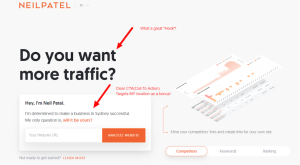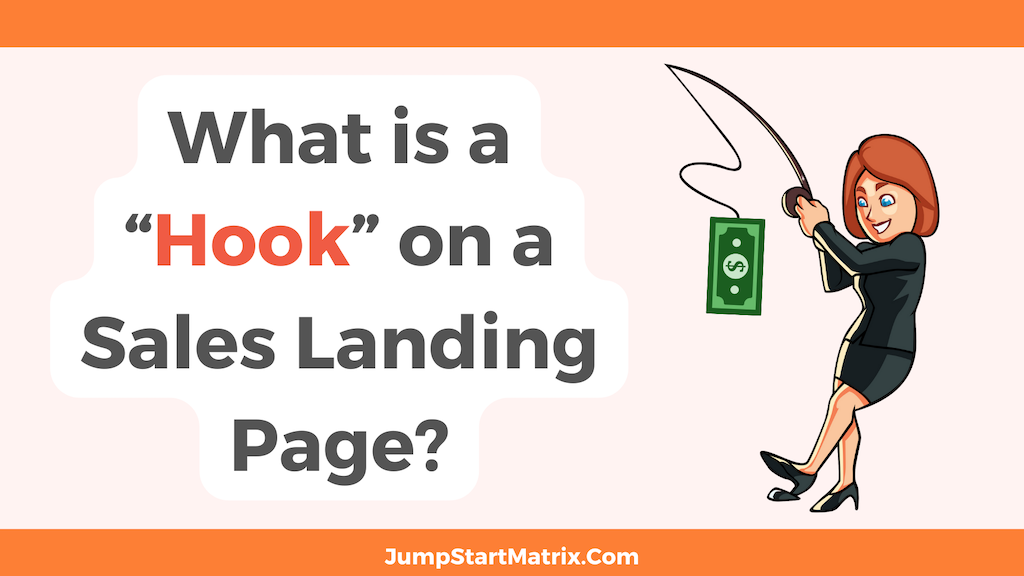A Hook on a sales landing page refers to a compelling and attention-grabbing element or message, designed to captivate visitors and entice them to take a desired action, such as making a purchase, signing up for a service, or providing their contact information.
The Hook serves as the initial touchpoint of engagement and persuasion- and makes your potential client KEEP READING
Recently I attended an online Event that discussed what elements MUST be on any (high converting) Sales Landing Page.
An almost ‘irresistible’ Hook was the first thing discussed….. So, let’s talk about just what that is!
Why IS the “Hook” crucial for your Landing Page?
Attention-grabbing: In our digital age, people have shorter attention spans and are constantly bombarded with information.
A well-crafted hook helps to cut through the noise and immediately grab the visitor’s attention, compelling them to stay on the page and explore further.
Engaging the audience: A hook should resonate with the target audience, addressing their needs, desires or pain points.
It creates an emotional connection, piques their curiosity, or offers a solution to their problems.
By doing so, it engages the audience on an emotional level, making them more receptive to the sales message.
Differentiation: The online marketplace is highly competitive and consumers have numerous options available to them
A strong hook helps differentiate a product or service from your competitors, by highlighting unique selling points, special offers or exclusive benefits.
It conveys why the offer stands out and why the visitor should choose it over other alternatives.
Conversion optimisation: The primary goal of a sales landing page is to convert visitors into customers or leads.
A compelling hook plays a crucial role in driving conversions.
It entices visitors to take the desired action, whether it’s making a purchase, requesting a demo, or subscribing to a newsletter.
Without an effective hook, your visitors may quickly lose interest and navigate away from your page, resulting in lost opportunities (i.e. Sales)
Do You need Copywriting/Conversions Help? Book that FREE Call Now!How do you create a good ‘Sales Hook’?
To create an impactful sales hook, it’s important that you understand your target audience, conduct market research and craft a message that resonates with their needs, aspirations, or challenges.
A combination of persuasive copywriting, appealing visuals and a clear CTA ( call-to-action) is often employed to maximise the effectiveness of the hook on a sales landing page.

Neil Patel’s Home Page is a great example of a landing page that has a great “hook” and a clear CTA ( Call to Action) with a lot of white space- no distractions
Crafting a Hook – Tips from other Experts
Alex Cattoni explains
“In copywriting and marketing terms, a hook is exactly what it sounds like — a concept or an idea that gets people interested in what you have to say… and what you have to offer.
Therefore a good hook has the job of reeling in a prospect by getting their attention enough to take the next step.
Because, let’s face it, it doesn’t matter if your copy is the most interesting, engaging, well written masterpiece on the planet, if you can’t get your prospect’s attention – does it even matter?”
Hubspot has 5 Tips on Hooks ( based on their Sales reps experience)
1. Do your customer research.
To create a sales hook, you’ll want to start by researching the customer — including their unique challenges, pain points, and needs.”
2. Figure out the customer’s pain points
As any psychologist will tell you: The pain of losing is twice as powerful as the pleasure of gaining.”
3. Ask a question as your sales hook.
An example, “You could say something like, ‘How many hours does it take you a week to create reports?’ It’s great when you get a response like, ‘Way too long’ back.”
4. Practice active listening skills.
Giving an effective hook isn’t about making a statement and walking away — instead, it’s about spending more time listening to the prospect than you spend speaking.”
5. Make it personal and have some fun with it.
These prospects are people, after all, with a myriad of interests and hobbies outside of work — figure out how to connect with them on a personal level, and you’ll find it easier to gain their trust and establish a strong relationship from the beginning.
CopyBlogger says
“A hook is a tool copywriters use to capture the attention of an ideal prospect, to interest them in reading every word on the page, ultimately leading them to take the desired action you’ve chosen.
A great hook captures our imagination.
It allows us to believe that our lives can be better. And they are almost impossible to ignore.
The hardest part of creating a hook is knowing how to find it.”
ConvertFlow has this to say:
The 5 Ws of launching a high-converting hook
- Whenever you’re launching a hook on your website, answer these five questions.
- Who are you engaging?
- Why are you engaging them?
- What is your message?
- Where are you engaging them?
- When will you engage them?”
ClickFunnels talks about
What Is the “Hook, Story, Offer” Framework?
In online marketing, the “Hook, Story, Offer” framework is a simple and effective method for writing sales copy anywhere and everywhere — for ads, emails, landing pages, sales funnels, soap opera sequences, and more.
Hook — It all starts with a hook. This is a headline and subheading that grabs your target market’s attention… something that triggers their curiosity and makes them read just a little bit more.
Story — Next, you tell an interesting and compelling story about how the product you’re selling changed your life… and how it changes your customers’ life as well.
Offer — Finally, you make your offer. And the price/value ratio is so compelling that your target market will have trouble saying “no”.”
Neil Patel is well known and has some great visual examples in this article – he notes
What should a landing page include?
While the exact format may vary, landing pages should include:
- A headline that includes the main keyword
- Subheading(s) that clarifies the heading
- A description of the offer
- Image, video, or illustration
- CTA (Call to Action) button or form
- (optional) Trust elements such as customer logos, reviews, or testimonials
and…Landing Page Example Conclusion
These examples can serve as an inspiration to create a high-converting landing page.
To get the most out of your landing page, be sure to:- Find what your best customers struggle the most with and then directly destroy this objection with a short and punchy headline.
- Use credibility and videos if possible.
- Know your goals — Is it to get their email, phone, ook a call, start a free/paid trial, or something else?
- Use clear and to follow Call to Actions.
Finally: always, always optimize your landing pages.”
No Time to Create a Sales Landing Page from scratch? Book a Free Call!
Or Contact JumpStart Matrix

